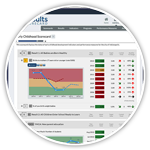People talk about culture change the way they talk about magic. We know this wonderful transformation is needed and will somehow happen, but we’re not sure how.
Let’s take a shot at a definition of organizational culture. Organizational culture is the range of accepted norms of for what people in an organization think and how they act. An organization might have a dominant culture and numerous subcultures. Subcultures might vary by program, profession, or organizational role. Organizational culture also includes a story line or mythology about why the norms exist the way they do.
Culture change then is any significant variation in or deviation from organizational culture or subculture. Culture change can be positive or negative. Sustained culture change is any culture change that survives some defined degree of turnover in key positions. It is worth noting that culture change is not a smooth transition. There are holdouts. Some parts of the organization go ahead of others. Some people never get it.
It is arguable that there are three elements needed for culture change to take place. This is a kind of hypothesis that might be tested with regard to creating a results culture.
1. Leadership: No culture change happens without leadership. It may be possible to talk about the evolution of organizational culture without leadership direction. But any form of deliberate change requires leadership.
2. Vision and small steps: Culture change requires the odd combination of vision and small steps. First, a vision of what the organization culture should be, that is a picture of destination. Deliberate or directed change also requires a well defined series of small steps that can begin the process and move it forward. Massive overhauls are often not practical and usually don’t work. So culture change requires a pathway of small steps that lead to bigger change. One guide to these small steps is the RBA Self Assessment Questionnaire new version (available on resultsaccountability.com). Start with one supervisor identifying and using performance measures. Then two supervisors, and so forth. After the accumulation of enough small steps, it is possible to reach a tipping point where change happens much more rapidly. It is worth noting here that among the seemingly small steps to take is the change in forms and formats for strategic plans, budgets, RFP’s and contracts. Forms are the skeleton of any organizations culture. They can live for decades. And if you can change them the change can last for decades.
3. Finally, feedback. Any change process requires a feedback loop to see if you are making progress. Two types of feedback are needed. Information is needed on the extent of implementation. One can use the RBA Self Assessment Questionnaire to calculate a score on the extent of implementation. The second type of feedback is on whether curves are turning on key measures.



